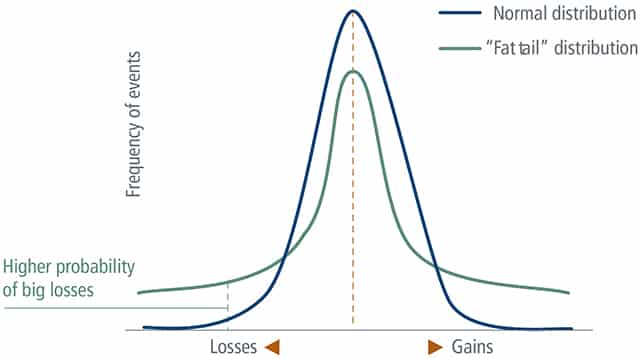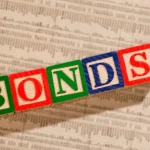This post may contain affiliate links. We may receive compensation when you click on links to those products at no additional cost to you. Read our full disclosure here.
The legendary economist Paul Samuelson once famously said: “Investing should be more like watching paint dry or watching grass grow. If you want excitement, take your money and go to Las Vegas.” While I definitely agree with that statement, I do believe that there is a time and a *small* place for some fun in higher-risk investments.
In this article, we’ll explore what constitutes risky investments and what percentage of your portfolio should be in risky investments
What Are Risky Investments?
In layman’s terms, risky investments are investments that have the potential to make a lot of money; but also have the same potential to lose a lot, or even ALL of your money.
Some examples include:
- Cryptocurrency
- Derivatives like futures and options
- Speculative stocks (Gamestop and AMC I’m looking at you)
- Penny stocks
- Forex trading
- Day trading
- Leveraged ETFs
- Angel investing
- Venture capital, etc.
These investments and/or investment strategies are risky because they have a higher probability of big losses, as seen in the illustration below. This means that if you invest $10,000 in a risky investment, the probability of you losing a lot of money is higher than in a more “normal” and less volatile investment.

You may be thinking: “The graph shows that the probability for big gainz is bigger too right? That should offset the losses right?”
Great point. However, here’s what you need to understand:
The percentage of required return to recover losses increases as the percentage of loss increases. This is because when you lose money = you have less money to reinvest. Thus, you will need a higher return to recoup your losses.
Here’s a table that illustrates how losses can compound and how much one would need to make to recover losses:
| Initial Investment | Loss Amount | Percentage Loss | Remaining Balance | Required Return to Recover Loss |
| $10,000 | $1,000 | 10% | $9,000 | 11.1% |
| $10,000 | $2,000 | 20% | $8,000 | 25.0% |
| $10,000 | $5,000 | 50% | $5,000 | 100.0% |
| $10,000 | $7,000 | 70% | $3,000 | 233.3% |
| $10,000 | $9,000 | 90% | $1,000 | 900.0% |
This is why while risky investments may result in home runs through bigger gains, suffering just ONE big loss can set you back a ton especially if you’re risking a big percentage of your portfolio.
Factors to Consider When Determining the Percentage of Risky Investments in a Portfolio
Now that you have a better of what risky investments are and the potential risks and rewards, there are several factors that investors should take into consideration to determine what percentage of risky Investments should be in a portfolio.
- Risk Tolerance: An investor’s risk tolerance is the degree of risk that they are willing to take on. Some investors are comfortable with a higher level of risk and volatility, while others prefer a more conservative approach. If you have a higher risk tolerance, you can perhaps have a higher allocation to risky investments.
- Investment Goals: Investment goals are the objectives that investors want to achieve through their investments. If your goal is to generate income, risky investments may not be the best option to overweight in your portfolio.
- Time Horizon: The time horizon is the length of time that an investor has to achieve their investment goals. Investors with longer time horizons may be able to tolerate more risk in their portfolios because they have more time to recover from market downturns. Conversely, investors with shorter time horizons may prefer a more conservative approach to minimize the risk of losses.
- Financial Situation: If you have a lot of financial resources, you may be able to have some “play money” for risky investments. However, if you’re struggling to pay rent, you may want to avoid risky investments as you cannot afford to lose what is necessary for survival.
Different Approaches to Determining the Percentage of Risky Investments in a Portfolio
There are two main approaches that investors can take to determine the appropriate percentage of risky investments in their portfolios.
- Rule of Thumb: A good rule of thumb is not to have more than 10% of your portfolio in risky investments. If you’re more conservative, only allocate 5% to risky investments. This way, the losses will not impact your overall portfolio too much and any gains can still improve your portfolio performance.
- It is also a good idea to have a separate investment account from your retirement portfolio so that you’re not tempted to add more money to make up for losses.
- Portfolio Optimization: There are many portfolio optimization strategies that use mathematical models to determine the optimal portfolio for an investor based on their risk tolerance and expected returns. Portfoliovisualizer.com is a great free tool to create optimized portfolios using your ticker of choice. See below for an example allocation:

As you can see, if I wanted to maximize the portfolio’s Sharpe Ratio, the portfolio optimizer is allocating less to speculative investments like GME and AMC due to their high volatility compared to their risk from 1985-2023. Note: You can optimize based on different goals like minimizing volatility, maximizing return, etc.
Impact of Over- or Under-allocating to Risky Investments
Over- or under-allocating to risky investments can have significant impacts on an investor’s portfolio risks and returns.
To illustrate the impact of risky investments on a portfolio, I’ve constructed 3 portfolios using VOO, AGG, and IWC which is an ETF that tracks micro-cap stocks, with varying exposures to IWC and AGG. I chose IWC to represent risky investments because it tracks smaller companies that are riskier by nature and also has a sufficient history to analyze data.

As you can see, the higher allocation to IWC has the highest annualized 5-year total returns BUT is the riskiest in terms of Max Drawdown and Standard Deviation of returns. A high allocation into risky investments also results in a lower Sharpe Ratio which indicates that the risk-to-reward ratio is the worst.
Do note that IWC is an ETF that is technically diversified and thus is already “safer” than other risky investments like individual positions speculative stocks, options, meme coins, etc. This means that volatility and risks should be understated in this example and you should be more careful when allocating to risky investments in your portfolio.
Final Thoughts
To sum up, investing is usually dull, but high-risk investments can be exciting and fun and you need to know the possible risks and rewards before investing a portion of your portfolio in them. Risky investments can cause significant losses that can be difficult to recover from so it may be wise to only allocate a small portion toward them (<10%).
Be sure to do your due diligence, and only invest in what you can afford to lose!
The opinions expressed in this article are for general information purposes only and are not intended to provide specific advice or recommendations about any investment product or security. If you have questions pertaining to your individual situation you should consult your financial advisor.
This post may contain affiliate links. We may receive compensation when you click on links to those products at no additional cost to you. Read our full disclosure here.






